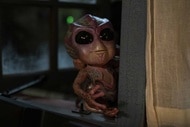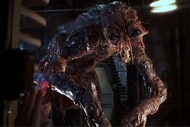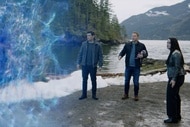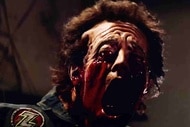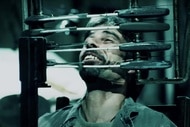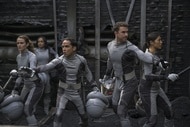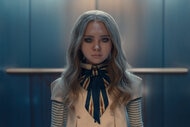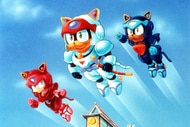Voyager's end: Every Star Trek series finale, ranked

For over 50 years, Star Trek has served as one of pop culture’s biggest load-bearing columns. Hundreds of hours of television and 13 feature films later, Trek is more popular now than ever — as proven by Star Trek: Discovery, Lower Decks, Star Trek: Picard, and more Trek shows on the air or in the works than ever before. Of course, each of these journeys has to end, and some are better than others.
As Star Trek’s future boldly goes forward, fans can’t help but get nostalgic for its past by revisiting previous shows via streaming — especially Star Trek: Voyager. The adventures of the instantly iconic Captain Janeway and her crew, stranded in a faraway corner of the galaxy, have become increasingly popular thanks to new fans discovering Voyager on Netflix and spending time with one of the ‘90s best and most inclusive series. As Voyager’s series finale — the somewhat divisive “Endgame” — turns 20 this year, SYFY WIRE figured it was a good time to beam on down for our definitive ranking of every Star Trek series finale ever.
06. Star Trek: The Original Series - “Turnabout Intruder” (1969)
“Turnabout Intruder” was never intended to be the series finale of the classic Star Trek series. This infamous Season 3 episode, which features a cheesy body swap premise with an even cheesier execution, became the last hour of the Original Series to ever air due to declining ratings and budget concerns. NBC decided to put the Enterprise in mothballs and go out on an installment that featured Captain Kirk (William Shatner) trading bodies with a former love and current mad scientist, Dr. Janice Lester (Sandra Smith). Why? So Dr. Lester could satisfy her lifelong (but, as scripted, unearned) dream of commanding a starship.
Fans consider “Intruder” to be one of the worst Star Trek episodes or the worst one ever, with the slog of a story working overtime to make a strong case for either. Based on a story by Trek creator Gene Roddenberry, “Intruder” struggles to find anything interesting for Kirk to do and makes the baffling choice to have its guest star character, Lester, drive most of the story. Audiences are more likely to believe that alien body swap tech exists before they would ever believe that Kirk’s best friends and shipmates would never notice that their captain has traded places with a mentally unwell baddie. Eventually, Spock discovers who his captain really is, but not before getting caught trying to help him (er, her) and getting court-martialled. The back half of the episode is a talky affair that strains one’s suspension of disbelief to the point of completely letting go of any interest to see how the matter resolves itself.
After watching this "Intruder," it’s amazing that Star Trek ever got a second chance to become what it is today.
05. Star Trek Enterprise: “These Are the Voyages…” (2005)
“It was a kind of a slap in the face to the Enterprise actors. I regret it.”
Co-writer and former Star Trek: Enterprise showrunner Brannon Braga didn’t sugar coat his feelings about Enterprise’s infamous 2005 series finale, “These Are the Voyages…”, in this 2017 interview addressing the problematic episode he developed and co-wrote with executive producer Rick Berman. While Braga and Berman thought framing the Enterprise finale as a “lost episode” of Star Trek: The Next Generation was a great idea while writing it, Braga soon realized after watching it that “great” was far from an apt description.
“Voyages” centers on Commander Riker, played once again by Jonathan Frakes, and the events surrounding TNG’s Season 7 episode “The Pegasus." Here, the Enterprise-D’s first officer uses the holodeck to help him solve his problems by revisiting the final mission of Captain Jonathan Archer (Scott Bakula) and the crew of the first Enterprise, the NX-01. That means that all the 22nd Century scenes featuring Archer and his crew are all holodeck simulations. Yup. For the first-time ever in Trek history, a series ends with holographic versions of the real characters that fans spent years following. It’s shocking how much wrong they managed to pack into one normal-sized episode of television — the first Trek finale since The Animated Series not to be feature-length.
Setting aside the fact that Riker never once mentioned an affinity for Archer, his ship, or his crew throughout his entire TNG tenure, making a 24th century character the focus of a series finale that takes place in the 23rd century denies agency to the Enterprise ensemble that deserves the spotlight — not have it stolen by characters who already had their fair share of it. (Having Marina Sirtis cameo as Counselor Troi adds even more distracting fan service.) Even Bakula was incensed with the story, with Braga recalling that this episode was the first time Enterprise’s lead actor ever got confrontational with the writer-producer. After watching the final product, we can see why.
04. Star Trek: The Animated Series - “The Counter-Clock Incident” (1974)
“The Counter-Clock Incident” allows Star Trek to combine two tropes it loves — morality plays and stories that deal with the effects of aging backwards. In doing so, fans are treated to an episode that works far better than it has any right to, largely due to its timeless themes and the earnest way the episode dramatizes them.
The sixth episode of The Animated Series’ second season, and final episode of the series, finds the Enterprise and her crew pulled into a “negative universe” where time moves backwards and causes Kirk and his officers to grow younger. (Star Trek: The Next Generation would tackle similar “de-aging” sci-fi in the high-concept episode “Rascals.”) But what’s unique about this episode is that, as Kirk reverts back to being a child, the first Captain of the Enterprise ever — Robert April — gets a second chance to relieve his prime years. April goes from being a senior citizen on the eve of retirement to his good ol’ days as a dashing senior officer, wrapping up his tenure in Starfleet with one hell of a final mission.
While the low-budget limitations of Filmation’s 2D animation haven’t (ironically) aged well, they don’t distract from “Counter-Clock” tackling ageism in a respectful way that reminds viewers of all ages to respect their elders and the value their experience and knowledge can bring.
03. Star Trek: Voyager - “Endgame, Parts 1 & 2” (2001)
Star Trek: Voyager’s “Endgame” has plenty of feature-level action to satisfy fans, but at the cost of giving them and the show’s crew the homecoming they deserve.
Lost for seven seasons in the Delta Quadrant, Janeway and her dogged crew aboard Voyager struggled across unexplored space to find their way back to Earth. One would think they would be given more than two scenes depicting their dream coming true, of seeing their home planet again, but that’s all “Endgame” gives them. The episode’s abrupt final moments conclude the series on one of the franchise’s most underwhelming and anticlimactic notes.
“Endgame” opens with Voyager’s crew already back on Earth, having lost their Borg attache, Seven of Nine (Jeri Ryan), in the process. This loss haunts Captain Janeway (Kate Mulgrew), who, now an Admiral, pines for a second chance to make good on her promise to bring every member of her crew back home. With the help of time travel, Janeway finally gets an opportunity to re-do her voyage home — which leads to one final confrontation with the Borg Queen (Star Trek: First Contact’s Alice Krieg). In the process, Janeway seemingly wipes out the Borg (or, at least, defeats them — how they survived this fate is left unclear when they reappear in Star Trek Picard). That’s a seismic event in the Trek Universe, and the finale has barely time to pay it lip service because the two-parter has to rush to the last scene: Where Voyager is joined by a few starships and ushered back to Earth before the credits roll.
Seven seasons spent with this crew, rooting for them to get home, and the show can’t be bothered to spend any significant time exploring how reaching Earth feels for those who doubted they would ever see it again. It’s a baffling, rushed choice that leaves fans wishing the series went with its original finale plans: Dedicate a mini-arc of episodes in the final season to show Voyager’s return to Earth and how the crew re-enters their lives. The dramatic potential there alone is more satisfying than most of “Endgame.”
02. Star Trek: Deep Space Nine - “What You Leave Behind” (2000)
After devoting its last two seasons to a largely serialized arc concerning the Federation’s war with the evil Dominion, Star Trek: Deep Space Nine wrapped up its seven-year run with a near-Biblical finale full of action, heart, and loss.
Captain Sisko (Avery Brooks) began the show as a brooding commander who couldn’t wait to leave his new post — a former Cardassian space station in orbit of the Bajoran homeworld. But by the end of “What You Leave Behind,” he literally gives his life to save both DS9 and the Bajoran people that view him as an emissary for their gods, the Prophets. Sisko’s sacrifice calls back to the show’s first episode, and his dealings with the Prophets — a race of non-linear beings worshiped by the Bajorans. His corporeal life is just the beginning, as Sisko’s death seemingly features him transcending into a higher plane of existence, one that, at first, he wanted nothing to do with.
Sisko’s story coming full circle is just one of the many satisfying and poetic beats found in “What You Leave Behind.” The episode finds a wildly entertaining, if at times uneven, balance between epic space action and dramatic scenes wrapping up seven years of some of the best serialized storytelling the genre has ever done. (The less said about the so-so blue screen effects depicting Sisko’s weird, ethereal battle with his nemesis, the evil Gul Dukat, the better.)
But the show is more interested in its character moments, however, giving its exceptional ensemble cast some truly moving moments to shine in the finale’s back half. And while the final scene in the holosuite, at the crew’s favorite Rat Pack-inspired night club, feels a little too long and self-indulgent, it’s the perfect ending for this crew and their journey. At the start of their mission, they couldn’t have been any more discordant. They shouldn’t have been in the same room, let alone on the same team. But, as “What You Leave Behind” movingly proves, that’s the definition of family. And that’s exactly what this crew became to each other and for their fans.
01. Star Trek: The Next Generation - “All Good Things…” (1994)
“All Good Things…” is the best Star Trek series finale ever. It’s the one that all Trek finales are measured against. 27 years after it originally aired, none have come remotely close to matching it.
Written by Brannon Braga and Ronald D. Moore, “All Good Things” proved to be a better cinematic-worthy adventure than The Next Generation crew’s first movie, Star Trek: Generations. The briskly plotted, feature-length episode, and its compelling storyline involving paradoxes and second chances, features Captain Picard (Patrick Stewart) moving back and forth through time. He slips in and out of three key time periods: The past, just before the launch of Enterprise-D’s first mission; the present, and the future. Here, Picard is a very retired — and very old — man who runs his family vineyard. He also struggles with a debilitating neurological syndrome that makes it hard for his former shipmates to believe him when he says he’s playing Sliders across multiple timelines. Picard’s mission requires that all three versions of his crew work together, under the manipulative watch of the omnipotent Q, to stop an anomaly from unraveling existence as we know it.
The tension and stakes couldn’t be higher, as TNG gives the cast and their characters a perfect final episode that brings them together as a family in ways the series left surprisingly unexplored for most of its run. Watching a futuristic Enterprise, blasting newly-mounted phaser cannons, fly vertically for the first time in Trek history proves to be as entertaining as the smaller, quieter beats between characters are. Especially the scenes where Picard has to convince his untested crew in the past to follow him and their counterparts on a mission that will cost them their lives.
But the episode’s beating heart lies in its final moments, where Picard finally joins his crew for their regular poker game. The first time Picard ever sits down with his crew at their poker resonates with his officers as deeply as it does with fans, which is a testament to the finale’s commitment to giving Next Generation the action-packed, emotionally earned send-off it deserves.








